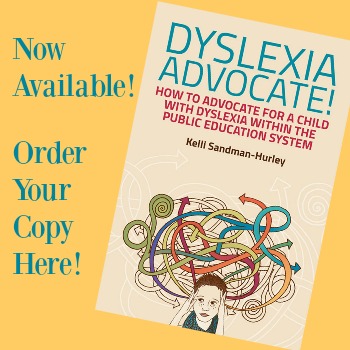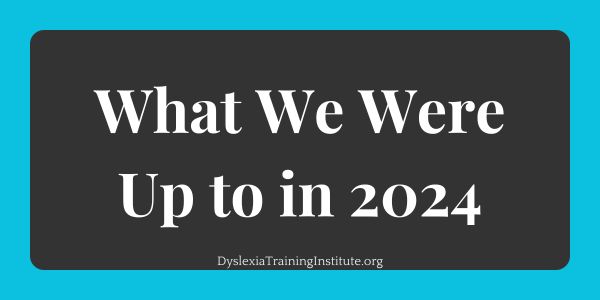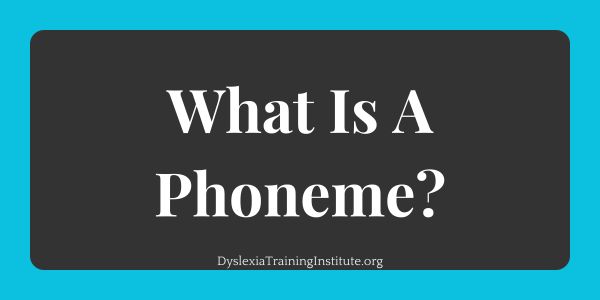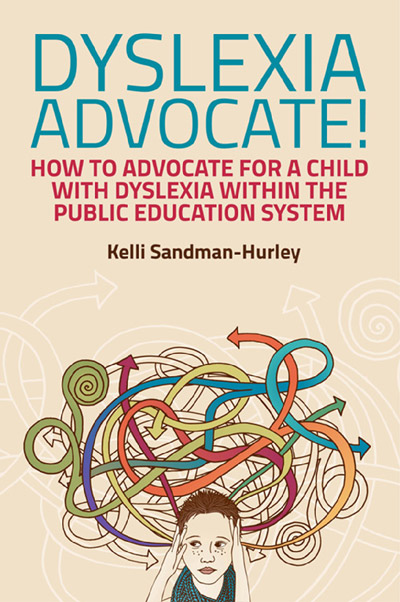 Download the PDF version of this article here.
Download the PDF version of this article here.
The Lowdown on Dyslexia was originally published here, but with new resources, new research, and even more detailed tips, Dr. Kelli Sandman-Hurley updated the original work below.
All About Dyslexia
by Dr. Kelli Sandman-Hurley
Every teacher in every classroom in every school in this country (and beyond) will come across several, if not dozens, of students who just can’t keep seem to get the ‘reading thing’ down. The students are smart, articulate, and creative, yet they omit small words, read slowly, have difficulty spelling, and stumble, guess or mumble through multisyllabic words. They are placed in reading groups for extra instruction and still don’t seem to ‘get it.’ And during his or her career, every teacher in every classroom in every school will ask themselves, “How can I help these children?” The answer is to learn as much as possible about dyslexia , because the child described above has dyslexia.
Below I have compiled a list of resources in response to questions from dozens of teachers who asked about dyslexia. I am very excited to see so much enthusiasm for the topic and on behalf of the 10-15% of students with dyslexia everywhere we thank you for taking the time to learn more.
Before we get started, it is necessary to address some frequently asked questions and dispel some popular and pervasive myths:
- Dyslexia is not a vision problem and cannot be remediated by color overlays or vision therapy. Sure, those may help, but for true dyslexia, an intensive remediation is necessary. People with dyslexia see things the way people without dyslexia do, therefore is vision problems are suspected they need to be ruled out or remediated before a diagnosis of dyslexia can be made.
- Reversing letters and numbers is normal through the first grade, after that it is a red flag for dyslexia.
- Dyslexia occurs on a continuum; one student can have mild dyslexia while his classmate can have severe to profound dyslexia. They both have dyslexia and they both require remediation; one will just need less remediation than the other.
- Dyslexia can run in families and it is common for a parent to realize they struggled in school when they see their child struggling.
- There is no ‘cure for dyslexia’ because it is not a disease.
- Students with dyslexia do qualify under IDEA and it is listed under the definition for Specific Learning Disability (SLD) – don’t let anyone tell you otherwise.
- Students with dyslexia can and should be identified as early as kindergarten.
- Dyslexia can be diagnosed by a properly trained professional. However, it is not currently a medical condition and is not usually diagnosed by a pediatrician.
- Finally and most importantly, dyslexia is real, it exists and it can be remediated by a correctly trained educator using an Orton-Gillngham-based approach.
What is dyslexia?
The International Dyslexia Association defines dyslexia the following way:
It is characterized by difficulties with accurate and / or fluent word recognition and by poor spelling and decoding abilities. These difficulties typically result from a deficit in the phonological component of language that is often unexpected in relation to other cognitive abilities and the provision of effective classroom instruction. Secondary consequences may include problems in reading comprehension and reduced reading experience that can impede growth of vocabulary and background knowledge.
Adopted by the IDA Board of Directors, Nov. 12, 2002. This Definition is also used by the National Institute of Child Health and Human Development (NICHD).
To learn more about dyslexia, watch this short video:
http://ed.ted.com/lessons/what-is-dyslexia-kelli-sandman-hurley
How Can I help?: Develop Empathy
Before beginning the journey (and it is a journey) to help a student who is struggling with dyslexia, it is important to develop empathy. This will come in handy to ward off your own frustration of the slow progress some students make and create the patience needed to allow for extra processing time and constant repetition students with dyslexia require. Below is a list of simulations to help you get started on your path to dyslexia empathy:
Dyslexia for a Day: http://youtu.be/ZznFCz6V1cM
Dyslexia for a Day is also a kit that can be used by individuals or groups of experienced teachers, teacher training candidates, practitioners, immediate and extended family members, or anyone interested in learning more about dyslexia and what those with dyslexia often experience with reading, writing and processing. The kit walks participants through five different simulations: two reading, two writing and one processing simulation. It is designed to help individuals gain a better understanding of and empathy for those children and adults who struggle with dyslexia. http://dyslexiatraininginstitute.org/dyslexia_simulation_kit.html
PBS Misunderstood Minds: http://www.pbs.org/wgbh/misunderstoodminds/experiences/readexp1a.html
F.A.T. City: How Difficult Can This Be: http://youtu.be/Xx5kr2T7rK8
How Can I Help?: Building Background Knowledge
Unfortunately, dyslexia has been the victim of misinformation, myths and half-truths that have gone unchecked which has lead to many children and their families being denied the appropriate intervention (I will address the legalities of this later). Luckily, there are three legitimate and highly researched books that are must-reads for anyone interested in dyslexia and how to help those with dyslexia.
Books
Overcoming Dyslexia by Sally Shaywitz
This is the current go-to book for anyone interested in dyslexia and should be the first book you read. Dr. Shaywitz explains the neurological basis and the appropriate interventions in a fashion that is accessible and practical for parents, teachers, paraeductors and policymakers alike.
Proust and the Squid by Maryanne Wolf
A little denser than Overcoming Dyslexia and does an exemplary job of explaining how the brain has adapted to the invention of reading and why that has made reading difficult for some students – hence why dyslexia exists. Also, if you get the opportunity to hear Dr. Wolf speak in person don’t miss it, she’s phenonmenal.
Reading in the Brain by Stanislaus Dehaene
If you are interested in the science behind all the claims that dyslexia has a neurological basis and want to know more about the inner workings of the brain and reading, then this is your book. It is a fascinating read that requires some serious concentration, but the effort will be handsomely rewarded with a profound understanding of the reading process and dyslexia. This is an informational text and not a book to consult for practical applications.
The Dyslexia Empowerment Plan by Ben Foss
While other books tell you what dyslexia is, this book tells you what to do. Dyslexics’ innate skills, which may include verbal, social, spatial, kinesthetic, visual, mathematical, or musical abilities, are their unique key to acquiring knowledge. Figuring out where their individual strengths lie, and then harnessing these skills, offers an entrée into learning and excelling. And by keeping the focus on learning, not on standard reading the same way everyone else does, a child with dyslexia can and will develop the self-confidence to flourish in the classroom and beyond.
Professional Development about Dyslexia
Dyslexia Training Institute (DTI), www.dyslexiatraininginstitute.org
DTI offers an online course titled, What is Dyslexia? In this course you will be introduced to the signs and symptoms of dyslexia and learn about many popular myths. You will be given the opportunity to go in-depth with the scientific research and evaluate the remediations supported by research. We will also discuss current accommodations available to children and adults with dyslexia.
Bright Solutions for Dyslexia, http://www.dys-add.com/
Susan Barton travels the country to deliver onsite free presentations about dyslexia. You can find her schedule on her website.
International Dyslexia Association, www.interdys.org
The International Dyslexia Association is a national organization that is comprised of local branches. Many local branches offer workshops, trainings and conferences about dyslexia.
National Center for Learning Disabilities (NCLD), www.ncld.org
A comprehensive website about learning disabilities with a Dyslexia Toolkit that is free to download.
Movie about Dyslexia
Embracing Dyslexia – http://www.embracingdyslexia.com/
How Can I Help? Instructional Techniques
So, let’s get down to the nitty gritty. What really works with children struggling with dyslexia? The simple (or not so simple) answer is that instruction has to be a structured, explicit, multisensory program that is based on the Orton-Gillingham approach. There are many programs that provide the structured, phonics-based part of the equation, but the multisensory piece it missing. I have seen programs that are structured but not explicit, meaning the children are being told how to spell a word, but not why. The Orton-Gillingham approach teaches the student how the language works from the beginning. It builds upon itself and while this is occurring, the teacher is proving the answers to all the ‘why’ questions. For example, there is a rule for when to spell a word with ch versus tch. Educators that teach students to use their fingers to tap out the individual sounds of a syllable are employing a powerful multisensory tool and the techniques of an Orton-Gillingham-based program go on and on. Unfortunately, this training is not included in teaching certification programs or even graduate level education programs – which is why you have so many questions about how to help these very deserving students. The good news is that you can still get the training and below is a list of places where you can receive the training that you need to help those kids that baffle you.
Dyslexia Training Institute, www.dyslexiatraininginstitute.org
Overview of Orton-Gillingham
You will learn about multisensory teaching/learning, terminology used in the O-G method and V/A/TK strategies, phonemes of the English language, the importance of clearly isolating each phoneme, be given an overview of the seven syllable types, using real and nonsense words, syllable division, and word patterns.
Dyslexia Certificate Program
The certificate program is designed on quality evidence-based research and will teach you about dyslexia and train you in the first level of the Orton-Gillingham approach. The program consists of on-line coursework and a required practicum. Upon successful completion the participant will earn a certificate.
Bright Solutions for Dyslexia, http://www.dys-add.com/
Susan Barton offers certification in her Orton-Gillingham based program, Barton Reading and Spelling System.
Wilson Reading System, www.wilsonlanguage.com
Educators participating in Wilson Professional Development:
- Acquire multisensory teaching strategies and a comprehensive understanding of the structure of the English language
- Gain the confidence and experience necessary to succeed at teaching reading and spelling
- Improve their ability to diagnostically plan and implement a lesson based on the diverse needs of their students
- Learn to teach Wilson programs with fidelity resulting in sustainable success for their students
Dyslexia and Advocacy
Advocating for a child with dyslexia is extremely difficult. Mostly because of the lack of information and/or misinformation that has permeated school districts nationwide. To make this long story short would not do anyone any good, so below are some links to articles that explain several different facets of dyslexia and advocacy, including how to get a diagnosis.
Putting the D in to the IEP: http://www.specialeducationadvisor.com/putting-the-d-in-to-the-iep-why-advocating-for-a-child-with-dyslexia-is-so-difficult/
Suspect Dyslexia? Here are some tips to prove it: http://www.specialeducationadvisor.com/suspect-dyslexia-here-are-some-tips-to-prove-it/
Dyslexia: Hear us roar: http://www.specialeducationadvisor.com/dyslexia-hear-us-roar/
Dyslexiadr blog about advocacy: www.dyslexiadr.blogspot.com
Dyslexia: Taking the M out of the IEP: http://www.specialeducationadvisor.com/dyslexia-taking-the-m-out-of-the-iep/
Books about Advocacy
Wrightslaw: Special Education Law, 2nd Edition includes the full text of the Individuals with Disabilities Education Act, the IDEA regulations with analysis and commentary. From Emotions to Advocacy
Wrightslaw: From Emotions to Advocacy, 2nd Edition – The Special Education Guide includes tips, strategies, references, and Internet resources.
In Wrightslaw: All About IEPs, you’ll find clear, concise answers to over 200 frequently asked questions about IEPs.
Special Education Law and Advocacy Online Course
Dyslexia Training Institute, www.dyslexiatraininginstitute.org
In this class, participants will learn about the Individuals with Disabilities and Education Act (IDEA), IEPs, 504’s, letter-writing, receiving appropriate services and interventions, dispute process and resolution, as they all relate to a student with dyslexia.
How Can I Help? Accommodations
For students with dyslexia, the teacher that understands them and gives them accommodations could be the teacher that changes their entire outlook on school. Here is the short list and then a link to a previous article about what teachers can do to help a student in the classroom.
- Allow time to process information
- Do not require oral reading (without warning or practice)
- Do not mark off for spelling
- Toss the red pen into the trashcan
- Give less homework
- Allow them to shine in the subjects in which they excel
- Do not punish (i.e. keep in for recess) for work not completed during class
For a more comprehensive list of accommodations: http://www.ncld.org/students-disabilities/accommodations-education/accommodations-students-learning-disabilities
You are now well on your way to a thorough and accurate understanding of what dyslexia is, how to help in the classroom, in an IEP meeting and the resource room. The time you are taking to learn about dyslexia is increasing the likelihood that you will have a profound impact on a struggling reader – and his or her family. So enjoy the ‘a-ha’ moments, the moments where you realize a student you have fits the dyslexia definition, and the feeling of joy when you realize you can get the tools to help that student. Always remember – dyslexia is real and you have the power, and now the knowledge, to help.






I would add Dyslexic Advantage by Drs. Fernette and Brock Eide, as well as some information regarding twice-exceptional/gifted with dyslexia (2E) children, as RTI has made school impossible for them to survive. The 2E child is refused reading instructional interventions they require to read fluently and to spell, as in spite of significant dyslexia, their intelligence allows them to compensate enough to appear grade level–both their gifts and disabilities are ignored in this grade level standard ed approach of Common Core high stakes testing. Further, since they cannot read with word-by-word accuracy, the tests are terrible measurements of subject knowledge or amount of work–so they are given more work packets (instead of reduced homework) and test retakes before or after class. It’s become abusive in Florida, and the children can no longer survive it. These are this generation’s Einsteins being forced out of advanced classrooms, and out of schools, with no where to go (no private options either in many areas). Florida wrote its RTI policy to entirely remove the discrepancy model.
I want to get this training and certificate, but didn’t see how to get started.
Hi Kathy, You can find all of the information about our classes here: http://dyslexiatraininginstitute.org/classes.html and information about our certificate programs here: http://dyslexiatraininginstitute.org/certification.html.
How do I get started?